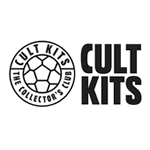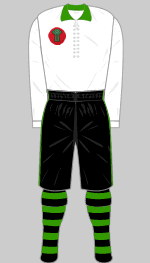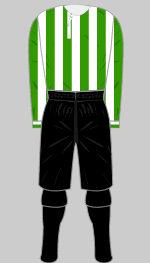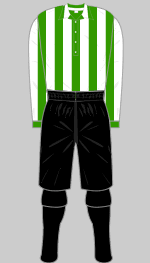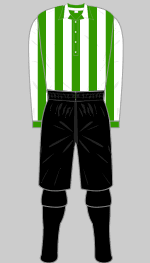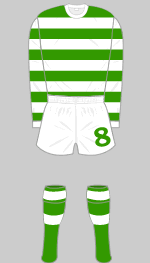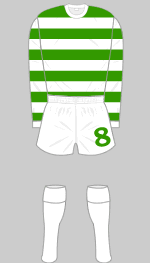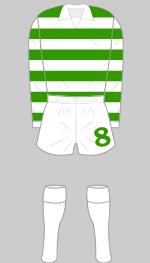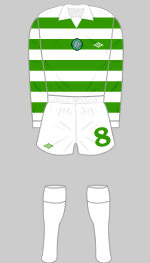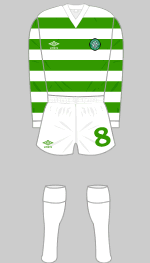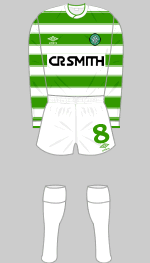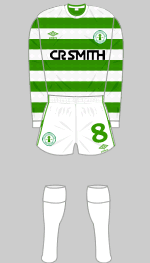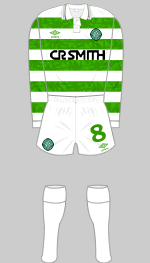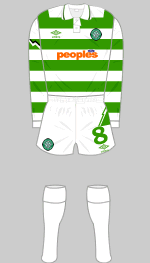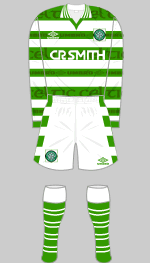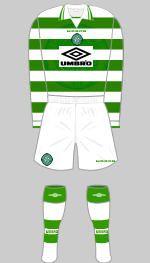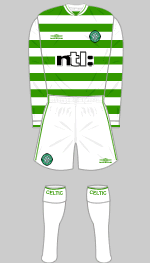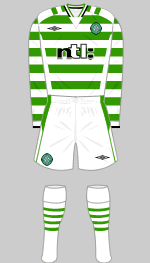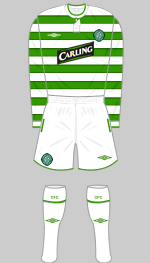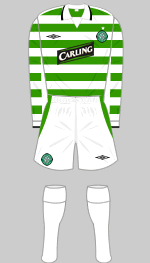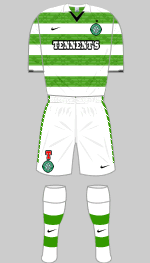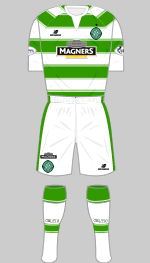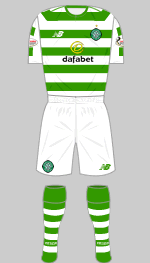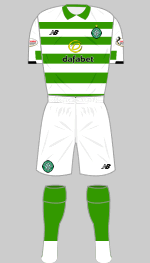Kit History
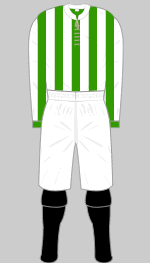
1891-1892 l q

1895-1897 a j l k
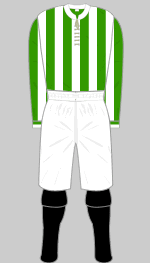
1898-1899 l
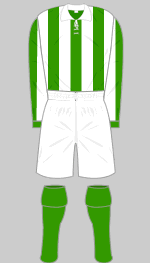
1901-1904 j l q u
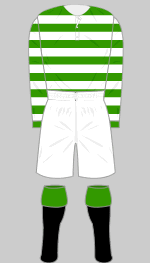
1904-1905 l q
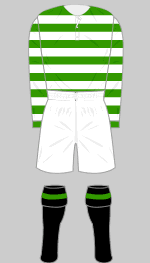
1905-1907 l q
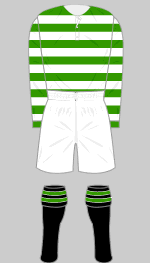
1907-1915 c l q
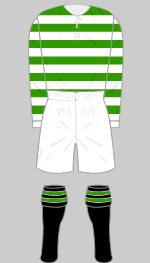
1915-1919 l q
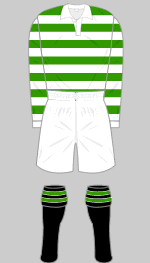
1919-1920 c l
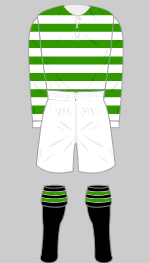
1920-1924 l y
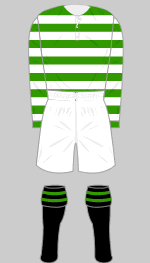
1924-1926 c l
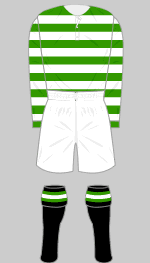
1926-1927 l
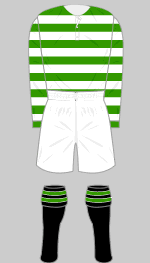
1927-1928 l
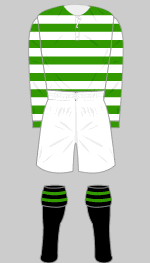
1928-1930 l
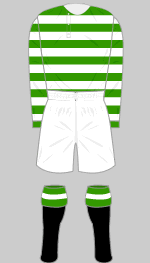
1930-1931 c l
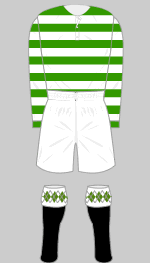
April 1931-1932 l q
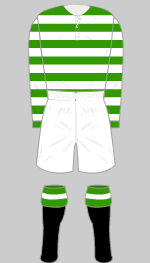
late 1932 l
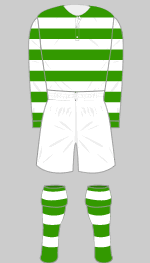
1932-1936 q
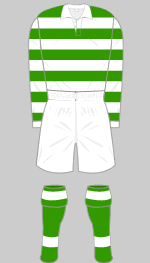
1936-1956 c l q
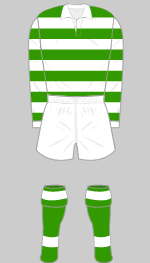
1956-1960 q
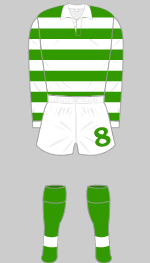
1960-Dec 1962 c k q
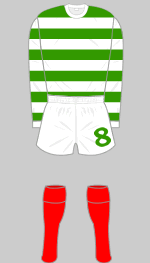
1 April 1970 u
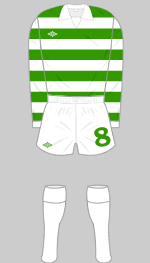
1976-1977 q
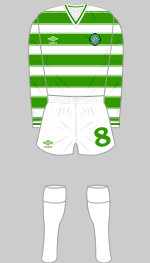
1982-1984 g q
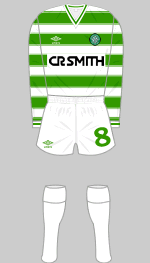
1984-1985 q w
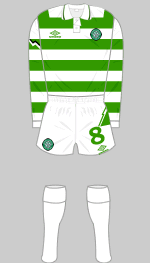
1992-1993 g q s
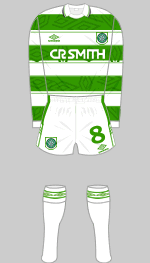
1993-1994 g h q
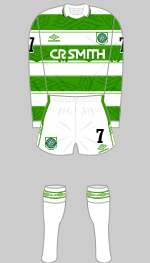
Aug 1994 t
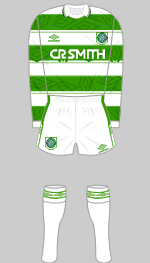
27 Aug 1994-1995 t
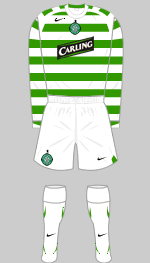
2005-2007 b e
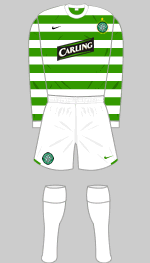
2007-2008 n
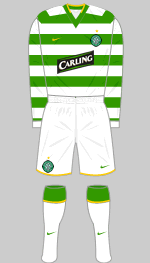
2008-2010 n
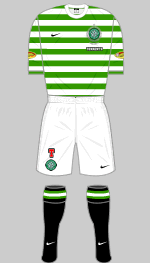
2012-2013 n
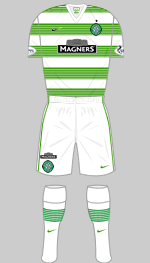
2013-2015 n
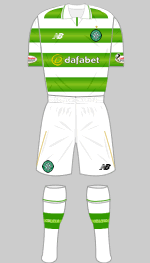
2016-2017 n
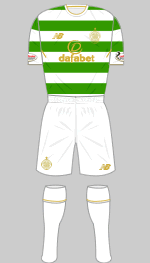
2017-2018 n
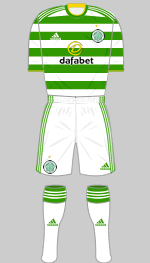
2020-2021 n
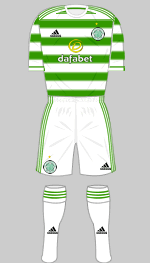
2021-2022 n
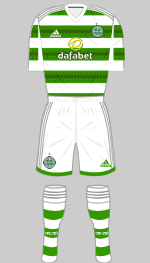
2022-2023 n
Background
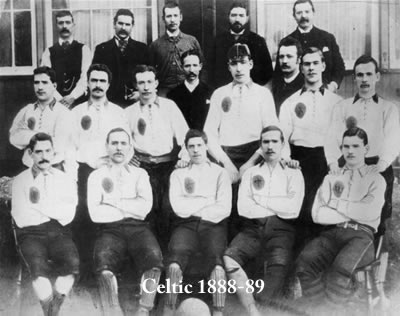 In the mid-1880s, the success
of Hibernians FC had inspired Irish communities throughout Scotland
to form their own clubs, usually with "Hibernian" or "Harp"
in their name. With a quarter of a million people of Irish descent living
in and around Glasgow, it was only a matter of time before a powerful
club would emerge. The driving force would be a member of the Marist
order originally from County Sligo, Brother Walfrid: on November 6 1887
a meeting was held in St Mary's Church, Calton, with the aim of
forming a football club to raise money and alleviate poverty in the
East End of the city. Brother Walfrid opposed the idea of calling the
club Glasgow Hibernians and came up with the name Celtic FC. (The title
was originally pronounced "Kel-tik" but Irish Gaelic speakers
used "Sel-tik" and this pronunciation stuck.)
In the mid-1880s, the success
of Hibernians FC had inspired Irish communities throughout Scotland
to form their own clubs, usually with "Hibernian" or "Harp"
in their name. With a quarter of a million people of Irish descent living
in and around Glasgow, it was only a matter of time before a powerful
club would emerge. The driving force would be a member of the Marist
order originally from County Sligo, Brother Walfrid: on November 6 1887
a meeting was held in St Mary's Church, Calton, with the aim of
forming a football club to raise money and alleviate poverty in the
East End of the city. Brother Walfrid opposed the idea of calling the
club Glasgow Hibernians and came up with the name Celtic FC. (The title
was originally pronounced "Kel-tik" but Irish Gaelic speakers
used "Sel-tik" and this pronunciation stuck.)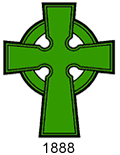 One of the club's
nicknames, "The Bhoys" dates from this era when they were
described as the "bold boys," the additional "h"
being added to phonetically represent the Irish pronunciation. In common with all Scottish clubs with Irish roots, Celtic adopted green and white as their colours and wore a Celtic cross on their earliest shirts.
One of the club's
nicknames, "The Bhoys" dates from this era when they were
described as the "bold boys," the additional "h"
being added to phonetically represent the Irish pronunciation. In common with all Scottish clubs with Irish roots, Celtic adopted green and white as their colours and wore a Celtic cross on their earliest shirts.
The fledgling club received generous support from the Edinburgh Hibernians, who played several exhibition matches to raise funds and lent Celtic their best players. While Brother Walfrid had only the highest motives his partners took a more hard-nosed attitude. John Glass, a builder from Donegal and Pat Welsh, a tailor who had left Ireland under furtive circumstances 20 years previously observed the coming of professionalism in England in 1885 and correctly assumed that Scotland would follow: furthermore a club that could draw on the loyalty of 250,000 potential supporters could make an awful lot of money. In August 1888, without the knowledge of Brother Walfrid or the club committee, Glass signed eight of Hibs' best players, having offered them (illegal) cash inducements. The consequences for Hibs were catastrophic and within three years the Edinburgh club had collapsed.
Although Celtic wore white shirts in their first season they changed into green and white striped jerseys when they faced Corinthians (who also wore white) at Kennington Oval on 16 February 1889. This style became their first choice the following season.
It did not take long before Celtic established themselves as one of the strongest sides in Scotland. They won the Scottish Cup in 1892, were Scottish League champions in 1893, 1894, 1896 and 1898 and won the Cup again in 1899 and 1900. In the Edwardian period they adopted their famous green and white hoops, won the championship an astonishing six consecutive times between 1905 and 1910 and the Scottish Cup on four occasions. They went on to win four consecutive titles between 1914 and 1917 but after this it was their arch rivals Rangers who dominated, Celtic managing a mere four titles and six cup wins between 1920 and 1939.
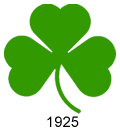 Although crests were not worn on Celtic's famous hooped jerseys, a large shamrock did appear on their change shirts from time to time. The first occasion was during the 1925-26 season, in some games in 1931 and then from 1948 to 1965, this motif became a regular feature of the white shirts with green sleeves worn on the rare occasions that Celtic changed.
Although crests were not worn on Celtic's famous hooped jerseys, a large shamrock did appear on their change shirts from time to time. The first occasion was during the 1925-26 season, in some games in 1931 and then from 1948 to 1965, this motif became a regular feature of the white shirts with green sleeves worn on the rare occasions that Celtic changed.
The intense rivalry between Celtic and Rangers reflects the sectarian division that has long been a feature of West of Scotland society and which continues to disfigure the game to this day. Nothing polarises loyalties so strongly as an "Old Firm" match, which have commonly featured outbreaks of violence fuelled by alcohol and open bigotry (both clubs are now acting to stamp out the singing of sectarian songs). Although Celtic are closely identified with the Catholic population, mostly of Irish origin, the club employed players and staff from both Catholic and Protestant traditions but refused, however, to allow non-Catholics to sit on the board of directors. Rangers, on the other hand were held to exclude Catholics until Graham Souness publicly repudiated their policy in 1989. In fact twenty Catholic players had played for the 'Gers but none were prepared to acknowledge their faith publicly.
Due to the idiosyncratic views of their chairman, Bob Kelly, Celtic did not wear team numbers until 1960, when they were applied to the front and back of players' shorts. This odd tradition survived until 1994 although numbered shirts were worn in European competition after 1975.
During the 1950s and 1960s, Celtic were overshadowed by Rangers and managed only one title in 1954 plus Scottish Cup wins in 1951 and 1954. In 1957 they won the Scottish League Cup for the first time, hammering Rangers by a record 7-1.
In 1965, Jock Stein, a former player took over as the club's first protestant manager and steered the club to their greatest period of success. They won nine consecutive championships between 1964 and 1974 but this side is best remembered for becoming the first British – indeed, northern European - side to win the European Cup. The "Lisbon Lions," all of whom were born within 30 miles (45km) of Glasgow, conceded an early penalty to Internazionale, the Italian masters of catenaccio defence, to win 2-1 with seven minutes left to play in the final of 1967. Remarkably Celtic won every competition they entered that season.
In 1970 Celtic played two epic matches against Leeds United in the European Cup semi-finals. For first leg at Elland Road, the referee ordered Celtic to change their stockings. It seems that the team had travelled with only their usual white socks and borrowed a red set from the hosts. Celtic won the game against all expectations by 1-0 and then beat Leeds again at Hampden in front of 136,000 fans by 2-1. Celtic went on to lose in the final against Feijenoord but had become the first Scottish or British club to reach two European Cup finals.
When Stein stepped down in 1978 he was offered the job of managing the Celtic Pools rather than a seat on the board and as a result, he left in less than amicable circumstances.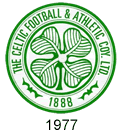
In 1977 the club finally bowed to fashion and adopted the club crest, featuring a four-leafed shamrock, on their shirts. (The outer segment was reversed out, with white lettering on a green background on the team shirts.)
Billy McNeil, the captain of the Lisbon Lions, took over as manager and led the side to three title wins (1978, 1981, 1982), the Scottish Cup (1980) and League Cup (1982) before he departed in 1983. He was replaced by another former player, Davie Hay who won the Scottish Cup (1985) and the following season, another league title on a dramatic final day on which Hearts needed to win against Dundee while Celtic needed to beat St Mirren by at least three goals. Hearts lost and Celtic won by 5-0 to clinch the title.
In 1987 McNeill (nicknamed "Caesar")
returned as manager, winning the domestic double in the clubs centenary season but the next ten years were a lean period. Rangers,
boosted by revenue from their lucrative football pool business had invested
heavily in redeveloping their ground and attracting the best 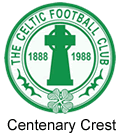 English
players to the club (English teams were banned from European competition
after the Heysel tragedy of 1985). Celtic fell behind, managing to win
only the Scottish Cup in 1988 and 1989. McNeill was replaced by Liam
Brady in 1991 but he failed to halt the decline.
English
players to the club (English teams were banned from European competition
after the Heysel tragedy of 1985). Celtic fell behind, managing to win
only the Scottish Cup in 1988 and 1989. McNeill was replaced by Liam
Brady in 1991 but he failed to halt the decline.
For their centenary season in 1988-89 a commemorative crest was worn, featuring the Celtic cross that appeared on their first shirts. The 1977 version was reinstated the following season.
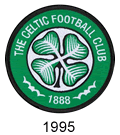 In 1994 The Bank of Scotland announced that it
would call in the receivers when Celtic exceeded their £5m overdraft.
With minutes to go, expatriate businessman Fergus McCann wrested control
from the families that had run the club since its formation. He initiated
a radical programme of modernisation, floating Celtic PLC on the Stock
Exchange (raising £14m) and rebuilding the crumbling Parkhead
(also known as "Paradise") into a 60,000 all-seated stadium
that rivalled the best in Europe. The club crest was revised to reflect the club's new legal status, with abbreviated text. Nevertheless, there was little cash
to spare for big transfers (although Swedish international Henrik Larsson
was signed for £650,000 and would become a Celtic legend).
In 1994 The Bank of Scotland announced that it
would call in the receivers when Celtic exceeded their £5m overdraft.
With minutes to go, expatriate businessman Fergus McCann wrested control
from the families that had run the club since its formation. He initiated
a radical programme of modernisation, floating Celtic PLC on the Stock
Exchange (raising £14m) and rebuilding the crumbling Parkhead
(also known as "Paradise") into a 60,000 all-seated stadium
that rivalled the best in Europe. The club crest was revised to reflect the club's new legal status, with abbreviated text. Nevertheless, there was little cash
to spare for big transfers (although Swedish international Henrik Larsson
was signed for £650,000 and would become a Celtic legend).
Celtic's tradition of wearing numbers on their shorts rather than on the back of their shirts was brought to an end after an incident in which the wrong player was booked by a referee who claimed he was confused by the lack of shirt numbers (and evidently had not noticed the crucial items were plainly visible on the shorts). The Scottish Football League instructed Celtic to wear numbers on their shirts from the start of the 1994-95 season. Celtic responded by adding numbers to the top of their sleeves, a decision that did not amuse the gentlemen at the SFL who directed the club to attach them to the back of their shirts, where they appeared for the first time at Ibrox on 27 August, breaking up the sacred hoops.
In 1998 Celtic won the Premier title and League Cup but this proved a flash in the pan and fans became increasingly disillusioned with the new regime. When Celtic were knocked out of the Scottish Cup by Inverness Caledonian Thistle, The Sun coined the memorable headline "Super Caley Go Ballistic, Celtic Are Atrocious." In 1999 former legend Kenny Dalglish returned as manager and while he restored the faith of the fans and won the League Cup, results continued to deteriorate.
The arrival of Martin O'Neill, a former Northern Ireland international, in 2000 marked the turning point. Under his leadership, Celtic reasserted themselves, winning the Premier League title in 2001, 2002, 2004 and the Scottish Cup in 2004 and 2005. Moreover, the club once again became a force to be reckoned with in Europe, reaching the UEFA Cup Final in 2003.
In 2005 the club severed their connection with Umbro, suppliers of their kits since the 1960s and entered into a contract with Nike. Gordon Strachan took over the manager's
seat, guiding the club to further Premier 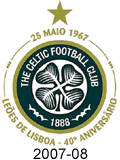 League titles in 2006 and
2007.
League titles in 2006 and
2007.
To mark the 40th anniversary of their European Cup win, a special crest was introduced for the 2007-08 season. The star that represents this triumph was retained when the 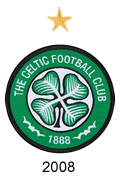 usual crest was reinstated the following season.
usual crest was reinstated the following season.
The dominance of the Old Firm was regarded by many neutrals as counter to the wider interests of the game in Scotland. The Premier League members earned the lions' share of TV revenues leaving the rest of the Scottish League to survive on scraps while the Old Firm were now so powerful that it was hard to see how their virtual monopoly could be broken until events in 2012-13 changed the landscape. The lack of competitiveness in the Scottish structure was reflected in the poor record of Celtic and their rivals in European competition since 1967 while the influx of foreign players since the 1980s stifled local talent. On a positive note, however, both Old Firm clubs firmly dissasociated themselves from sectarianism and bigotry of any kind.
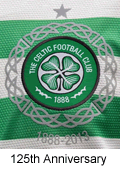 Celtic's record speaks for
itself: champions 44 times, Scottish Cup Winners 36 times,
Celtic's record speaks for
itself: champions 44 times, Scottish Cup Winners 36 times, 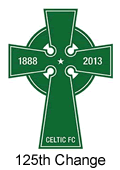 League Cup
Winners 14 times, European champions once. (Correct at 2013-14).
League Cup
Winners 14 times, European champions once. (Correct at 2013-14).
To mark the club's 125th anniversary in 2013 a rather fine retro kit was designed by Nike that included narrower hoops in the style adopted (by happy coincidence) 100 years earlier and black socks with green/white trim. A special crest was introduced with a celtic knot design embroidered round the traditional badge. A re-creation of the first ever strip from 1888 was adopted as third choice.
After Rangers were placed in the SFL Third Division for the 2012-13 season, Celtic faced 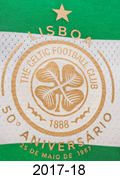 little real opposition in the top tier and regularly ran away with the title.
little real opposition in the top tier and regularly ran away with the title.
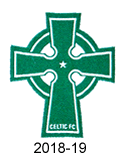 The 50th anniversary of Celtic's European Cup win arrived in 2017-18 so a suitable modification was made to the crest and a fine revival of the original 1967 strip was introduced, with a little gold trim to emphasise its significance.
The 50th anniversary of Celtic's European Cup win arrived in 2017-18 so a suitable modification was made to the crest and a fine revival of the original 1967 strip was introduced, with a little gold trim to emphasise its significance.
The regular crest was reinstated for 2018-19 but on the change strip a Celtic Cross appeared once again, a reference to the club's heritage.
When the 2019-20 season ended early, Celtic were already 13 points clear of second placed Rangers after 30 games (Aberdeen, in third place trailed by new fewer than 34 points). They were declared champions on 18 May, their ninth consecutive title.
When the 2020-21 season started it was widely believed they would make it ten titles in a row but pretty quickly the wheels came off. After poor performances in Europe, Celtic were knocked out of the League Cup by Ross County at Parkhead. By February they were trailing 18 points behind Rangers and manager Neil Lennon resigned. To cap it all, Celtic were knocked out of the Scottish Cup by Rangers to finish the season without any trophies for the first time in ten years. They found their touch the following season, winning the Premiership and the League Cup.
Sources
- a Brian McColl
- b Footystrips
- c London Hearts
- d Colours of Football
- e Red Card Scotland
- f Pop Art UK
- g Pete's Picture Palace
- h Sporting Heroes
- i Scottish League.net
- j Fraser Pettigrew
- k Dundee FC - Images of Sport (Paul Lunney 2001)
- l Alick Milne
- m Stuart Robinson
- n Celtic Official Site
- o Jon Alexander
- p Alexander Perkin
- q Kerrydale Street - an excellent independent Wiki site with a fine collection of team photographs.
- r Christopher Worrall
- s J Houston
- t Barry McKenna
- u Keith Ellis
- v James Watt
- w Gerard Murray
- x Mikey Riley
- y Football & the First World War
Photograph courtesy of Kerrydale Street. Crests are the property of Celtic FC.
